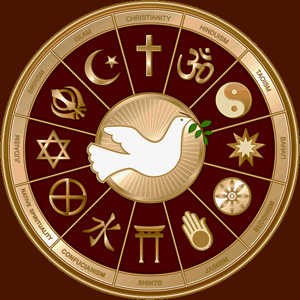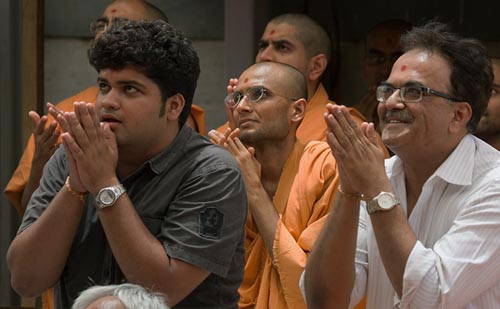About stature, status and collective identification
Widespread Confusion
That large groups of Western people are collectively confused can be clearly seen in how they indulge in consciousness-narrowers like trends, booms, games, and other attention-demanders such as smartphones, work, (social) media, political or religious views, and addictions. All of these maintain many collective identifications. This is also observable in the more spiritual realms (both Eastern and Western).
Identification blocks inner light. Group identifications block an enlightened society. People collectively cling to things that limit individual inner development including ideas, beliefs, faiths, and various -isms. As people collectively cling to one thing, what others cling to collectively becomes the opponent. Duality is born, and the essential and natural experience of unity disappears from society. This easily leads to conflicts when religious beliefs clash.
In daily life, we can easily fall into an unnoticed group identification: an idealism, a political current, a religious belief, or a popular trend. Especially when one stops being critical about what is genuinely being offered by political or spiritual trendsetters.
 In our society, a vast number of things are promoted in advertising and media, specifically to persuade large groups to identify with them. Because large, compliant groups generate high profits. We are inundated with trends and styles in clothing, food and drink, living, transport, etc., to make us follow. People identify with heroes, icons, influencers, and woke idealisms. Sometimes this leads to the collective adulation of leaders, as has often been evident in the history of countries.
In our society, a vast number of things are promoted in advertising and media, specifically to persuade large groups to identify with them. Because large, compliant groups generate high profits. We are inundated with trends and styles in clothing, food and drink, living, transport, etc., to make us follow. People identify with heroes, icons, influencers, and woke idealisms. Sometimes this leads to the collective adulation of leaders, as has often been evident in the history of countries.
In recent years, we were inundated with daily fear propaganda about ‘killer viruses’, leading society to collectively accept much disproportionality and the erosion of freedoms (along with many infringed rights). Fear, after all, is a source of collective identification and thus leads to collective delusion. This collective delusion can only occur if individuals lack knowledge of what identification is, what this mechanism does to the human mind, and how it actually goes ‘viral’ amongst large groups of people.
The mass media hype around gender ideology is another prime example of a continually fueled collective identification trend. Identification with ideals about one’s own body, to build an identity out of mental impoverishment, is popular among men and women who fully identify with the body. In the past, only bodybuilders modified their bodies to immense proportions… now, with the extensive use of harmful medicines, people mutilate their bodies for a lifetime. A constant affirmation like ‘I am not this body’ can then put an end to this ‘first veil of ignorance’, on the path to inner liberation from body ideologies.
Collective identifications can only arise when individual self-reflection on one’s own thinking, speaking, and acting is lacking. In short: only a lack of introspection and self-knowledge makes people follow collective identifications, which cannot arise/exist without individual identifications that aren’t seen and understood.d freed from any belief in separateness, inequality, or being ‘special’.
Self-knowledge by introspection prevents
being caught in group identifications
In more spiritual circles, for example, people collectively cling to widely accepted ‘true’ principles, often written down centuries ago, which may not have always been passed on in conscious awareness, potentially losing their essence. But even newer, modern ‘true’ principles are sometimes eagerly accepted by large, mindset-reinforcing groups. Globally and in a short time, a spiritual trend or boom can arise. New paradigms, sprouting from modern spiritual imagination, are collectively embraced, and their truthfulness is sometimes hard to gauge. The currently popular embraced idea of a ‘transition from 3D to 5D’ could fall under this, especially if people think it will just ‘happen’ to us.
Stature, or Status and Hierarchy
We, as individuals, not only attach ourselves to possessions and ideas and beliefs but also to status. Individually, we cling to many needs: the need for respect, to be seen and heard, for position, for our ‘name’, all of which are related to status. In fact, we have a strong need for attention for who we believe we are. Attention to our person, for what we do, and for what it means. Perhaps we even crave recognition. This is sometimes perceived as narcissism, but it is not. A good question we could ask ourselves is: ‘who do I think I am?’
 When someone is seen as a specialist in a particular field, they gain a certain stature among peers. In every organization, people have stature. Once someone is judged to have high stature, they have authority in that area. From this position, a lot of experience and knowledge transfer can take place, deepening and developing insights in that area. It’s very natural. Many can benefit from it in a meaningful way. This applies to every field: science (universities), politics (state and administrative science), and spirituality (esoteric schools).
When someone is seen as a specialist in a particular field, they gain a certain stature among peers. In every organization, people have stature. Once someone is judged to have high stature, they have authority in that area. From this position, a lot of experience and knowledge transfer can take place, deepening and developing insights in that area. It’s very natural. Many can benefit from it in a meaningful way. This applies to every field: science (universities), politics (state and administrative science), and spirituality (esoteric schools).
In the political world, when a wise leader emerges, we speak of an enlightened statesman or a wise king. Unfortunately, this now only exists in fairy tales. Many politicians are now only proposed and elected based on status or populist grounds, with little sign of any real stature left. In fact, many politicians contribute to the corruption of the political system.
Humans tend to attach themselves to social, religious, or spiritual principles. It stems from a natural desire for mutual connection, from our essence, but is hijacked by the ever-identifying ego in unconsciousness. ‘Staying connected’ is thus different from ‘wanting to belong’. The former arises from self-reflective awareness, the latter from unconscious identifications.
From collective identifications, someone’s stature, for instance, that of a leader, is turned into an ascribed status. And that’s something entirely different, as from collective belief in status hierarchical thinking emerges, almost always leading to an authoritative structure. This is a severe identification pitfall for large groups of people, having a strong limiting effect on mental and emotional clarity and individual inner freedom. The stronger an authoritarian-minded hierarchy becomes, the more individuals’ integrity is pressured. It can lead to severe conscience conflicts in those who are expected to follow orders from above. This can happen anywhere, in every hierarchical situation, such as in politics, with the police and the army, but also in self-proclaimed spiritual communities and cults.
When someone in the religious or spiritual world is seen as wise, they are referred to as a sage or enlightened teacher and have a high stature that many appreciate. This has nothing to do with status. Due to true stature, one is recognized as an authority. That there’s nothing wrong with this in itself is evident.
However, if a spiritual leader, attributed high status by many, is not truly internally free and wise, this connotation can also become an (attractive) identification pitfall for him. This can create in him the mindset that he is better or even elevated above others, that hierarchy is logical and desirable, and that there’s a difference in value between people. His personality, with stature and authority, then becomes an authoritative person with status, which is something entirely different.
In the hierarchical structures that almost immediately arise from this, various status-focused authoritarian personalities develop at every level, accepting or undergoing from ‘above’ and demanding or rejecting downward. Exaggeratingly, this can be called ‘licking up and kicking down’. Only truly internally developed individuals can remain completely free in hierarchical structures, function non-identified, and in essence, do only what’s necessary, regardless of what others think of it.
How Sacred is Sacred?
In religious and spiritual organizations, we recognize the title ‘sacred’. Essentially, sacred stands for ‘Whole’. We could assume that someone who has been declared sacred has realized and become a True human: a person who has overcome inner duality by letting go of all attachments causing separateness, and who has realized a sustainable self-reflective and detached state of mind. A person with the highest possible stature, living in truth and connection, because conscious connection from unconditional love is different from attachment arising from a need for love.
For highly developed individuals, titles and designations are created. Titles such as pope, bishop, rabbi, imam, etc., are awarded to individuals within religious movements. In the spiritual world, we recognize titles like buddha, lama, maharishi, and many others. It indicates a stature in wisdom, acquired through prolonged inner self-study. However, nowadays, in most cases, it merely conveys status (the Roman Catholic pope being the most glaring example) and then the title is no guarantee of inner wisdom, wholeness, reliability, or authority. Such titles also appeal significantly to the status-sensitive ego: of followers eager to assign status, but possibly also of those (including ‘teachers’) who enjoy being granted status.
Being awarded such a title isn’t wrong as long as one doesn’t become attached to it. If one gives oneself a title, which also often happens, it is completely meaningless because it precisely arises from identification with status and the desire to be seen as someone of stature. It stems from the urge to secure a certain position. This identification with status also applies to collectives.
Status, and in essence even stature, are fundamentally illusory. Only the inner clarity and wholeness in a person matter and can be distinguished from inner obscurity and division. Only a clear individual can see the inner state of others and not the other way around. An unclear and internally divided person cannot assess stature and will then assign status to those he respects or identifies with, or refuse stature to those he does not understand or represents something different.
 Assigning status to leaders can lead to blind obedience and veneration among non-autonomous people and to belief in a wrong (low or high) self-image. Moreover, it perpetuates the previously mentioned collective identification, most recognizable in religions. Essentially, there is no difference between mass identifications in religious and spiritual realms and those in political and social fields.
Assigning status to leaders can lead to blind obedience and veneration among non-autonomous people and to belief in a wrong (low or high) self-image. Moreover, it perpetuates the previously mentioned collective identification, most recognizable in religions. Essentially, there is no difference between mass identifications in religious and spiritual realms and those in political and social fields.
The status of church fathers with their ensuing influence, and the societal misery that emerged over the centuries from it, is chilling. The human suffering and oppression it caused are evident. But the status granted to political leaders can also lead to horrors, as Nazism and communism have shown. All maintain inequality and hierarchy, sometimes to the extreme.
The collective spiritual-religious identification in India is among the oldest we know. It also perpetuates a societal mis-deed (action from ignorance) in the form of the caste system, thereby maintaining a vast rich-poor disparity. The caste system consists entirely of status illusions for the benefit of the wealthy, exactly as racism did, for example, in pre-Civil War America. The ‘reincarnation: man-must-learn-in-his-many-lives principle’, which is still used to justify this inequality, is particularly useful. Moreover, the real meaning of the worshipped gods has mostly degraded into the worship of material trinkets in the form of statues and other colorful spiritual merchandising. Many rituals became religious machinations (such as ritual feasts or bathing in the open sewer, the Ganges).
Spiritual Realism
Anyone who would truly be sacred is certainly aware of all this and recognizes that unconditional love, which belongs to the Essence of the Absolute (as is also proclaimed in these circles), does not align with the deliberately maintained status quo that keeps large groups of people in poverty and misery. A true saint isn’t isolated in an ashram or temple, but for instance, stands in the street, as Jesus of Nazareth demonstrated to the world. They would, at the very least, propagate their genuine knowledge about unity-experience-disturbing (mass-)identifications, from Sânkhya and Yoga, or acquired Self-knowledge with a capital S. A saint would use all their resources, including financial ones, for the well-being of others, from unconditional love and a pursuit of happiness for every person on earth. (For instance: they wouldn’t want to own a lot of Rolls Royces – owning too much is, in fact, ‘inhumane’ – but would invest the value of such possessions in humane projects, where the needs are greatest. For they know the universal law: where one has too much, another has too little.)
For a saint or realized person, the following certainly applies: they have a conscious and very ‘clean’ working mental toolkit, and their Rational and Emotional Center are optimally developed.
Many recognized teachers have been declared saints. But being a saint doesn’t necessarily mean they have served humanity for consciousness-raising (teaching), although that is often the case. One can remain anonymous and unknown (like Yeron Porfyrios).
However, there are also many debatable saints, who were (posthumously) attributed status by church fathers or followers, but factually and verifiably did not possess the True stature.
Furthermore, as an ordinary person, without any (acknowledged) stature or status, one can certainly serve many people (teach) for consciousness-raising. So, ‘sanctity’ doesn’t essentially matter. Expression in word and deed (in actions), from the True and in Love, is what truly matters. That demonstrates true inner stature!
All these titles (whether given by others or self-proclaimed) can become wool over the eyes for those who want to become conscious. Sometimes it’s startling to see how people lose their autonomous power, embarrass themselves, and stutter, for example during a Q&A with a satsang-master. There’s a certain insecurity/submissiveness in the eyes and posture of the questioners, while outside of the satsang (in appropriate attire) they were still satisfied with their own spiritual progress and the emerging status feeling. Among the answers given by the master, there’s much laughter and approval from the audience, from those ‘who already get it’ and who might also momentarily attribute a slightly higher status to themselves than the questioner. And of course, people laugh a lot to please the master.
Every veneration of, or craving for status or a title is a powerful identification blockage in truth finding. Essentially, every human has the divine stature, provided they’re liberated from any hierarchical thinking and feeling, and freed from any belief in separateness, inequality, or being ‘special’.
